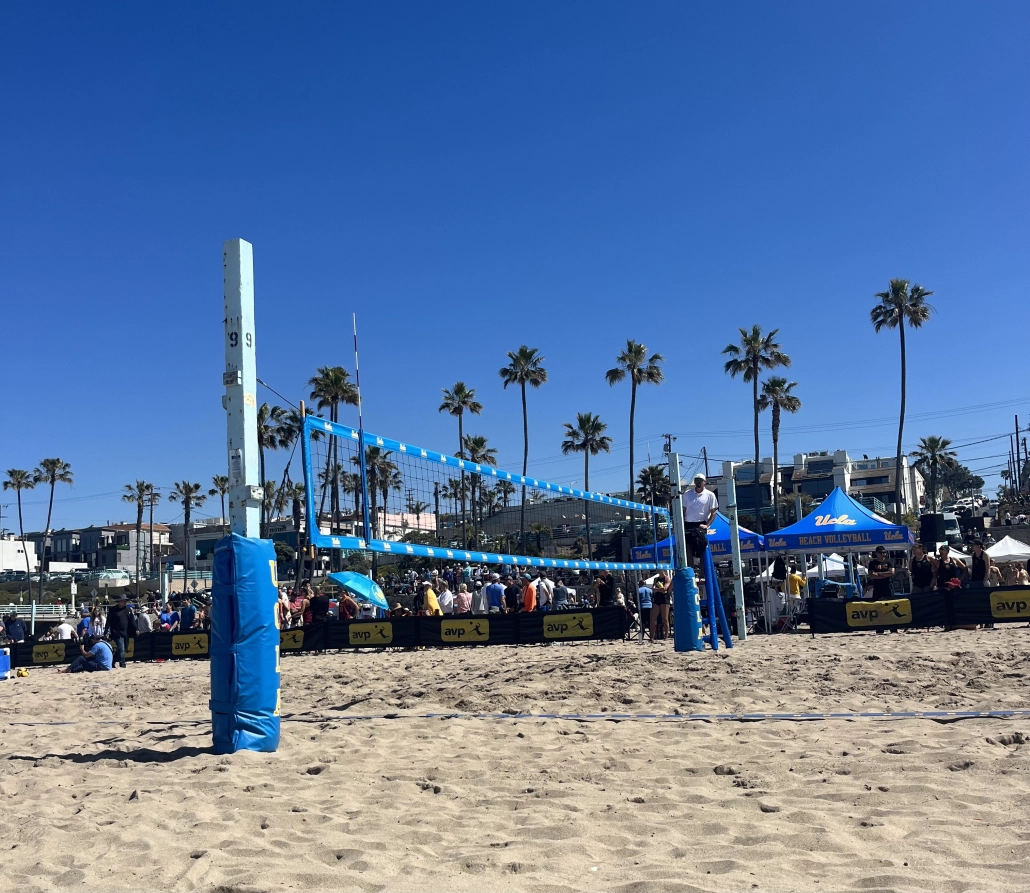THE CAGE
Bumming and balling: The sport of the city
Beach volleyball was born on the public beaches of Los Angeles, and continues to carry the spirit of coastal California.
Beach volleyball was born on the public beaches of Los Angeles, and continues to carry the spirit of coastal California.


Beach volleyball is Los Angeles at its most.
Sure, surfing gets a lot of attention out here, but unlike walking on water, modern beach volleyball was born right on the Southern California coast. The sport balances beauty and brawn and in less than a century, it’s spawned a rich history of camaraderie, professionalism and a culture that could only take root in Los Angeles.
Although volleyball adopted sand in 1915 at Hawai’i’s Outrigger Beach and Canoe Club, it wasn’t until the sport made its way to Santa Monica that beach volleyball began to resemble the exhilarating two-pair sport that we know today.
Santa Monica established itself as the official birthplace of the sport and the first beach volleyball tournament was played there in 1924. During the Great Depression, Angelenos continued to flock to the beaches where all it took was a cheap leather ball to meet new people and have a great time running around under the sun.
What was an escape from the hardships of life quickly became a lifestyle on its own when beach volleyball went full Hollywood. In the early 1950s, cameras crowded the California coast to create “Beachmania” — an entertainment show and beauty contest for beach volleyball players. And, in 1955, the best players would play for a kiss from star actress Greta Thyssen.
Even Wilt Chamberlain, arguably the NBA’s first pop culture superstar, began playing pickup matches in Santa Monica, sometimes with Bill Walton, and he was later enshrined in the International Volleyball Association Hall of Fame.
“[L.A.] is definitely an epicenter — you’ve got Hermosa, Manhattan, Santa Monica, you’ve got all these [Association of Volleyball Professionals] events, like pro events and sometimes [Fédération Internationale de Volleyball], the international tour and also another organization: [California Beach Volleyball Association],” said Lavender Billingsley, USC’s club beach volleyball social media manager. “I can definitely say that it’s kind of a culture, kind of a vibe … and you can play pickup games and it’s a really chill vibe.”
As Hollywood began to drive the direction of the sport, beach volleyball adopted what writer and former professional volleyball player Travis Mewhirter described as a “rebel” culture.
“It was volatile, mercurial, a sport run by testosterone-fueled men with an existence that embodied the California lifestyle: Sun, sex, drugs, alcohol, and money,” reads the Amazon description of Mewhirter’s book “Kings of Summer.”
The spirit of Los Angeles is magnificently embodied by the simultaneously fierce and relaxed nature of beach volleyball where fun, fitness and community are intensified and unleashed through sport. And, like most L.A. fads, beach volleyball has grown quickly and unexpectedly.
The tradition has spread from Santa Monica to Brazil, where every match has a score of samba music and festivities, and even throughout the globe to places like South Africa and Latvia. Similar to beach volleyball’s presence in Los Angeles, the essence of each city is expressed on public beaches through the game’s style of play.
With increased global attention, beach volleyball has become much more than an opportunity to put on a hot pink trucker hat, to be hot or to look at other hot people while flinging your body along the beach.
In the words of American beach volleyball legend and three-time Olympic gold medalist Kerri Walsh Jennings prior to the 2012 London Olympics Opening Ceremony via The Washington Post, “Sometimes it’s just the beer and the bikinis that get people to come and watch, but it’s the competition that’s keeping them there.”
With the sport’s unfathomable athleticism and fast pace, beach volleyball was recognized on an international level just a few decades after its inception. Sports like surfing took centuries to be introduced to the Olympics, but beach volleyball made its Olympic debut in the 1996 Summer Olympics.
Apart from competition ensuing on massive international platforms, beach volleyball continues to grow because the sport’s tournaments maintain the spirit of public play. From the amateur to professional level, tournaments typically transpire on public beaches. The best beach volleyball players in the world set up their tents beside older couples hunting for sand dollars, kids digging holes and folks playing beach volleyball recreationally. In fact, many of the in-person viewers are beachgoers who glanced over at the action and couldn’t help but get invested.
“For the most part, it’s an easy enough sport to understand and track. When you go to the beach, sometimes you don’t know that there’s a tournament happening there, so you might go to play pickup [and] you end up staying around to watch,” Billingsley said. “Especially the pro events, it’s so open to everyone, and the more support, the better, essentially, to grow the sport overall.”
Considering the balance between competition and leisure, beach volleyball truly captures the essence of Los Angeles. It’s a sport that was born on public land and continues to be played where anyone can practice and experience it.
Speaking of which, USC beach volleyball will start hunting down its fourth straight national title next week, and you should go to some matches because they’re the best things ever. You can watch USC’s duals, or smack a ball of your own on the sidelines, on campus at Merle Norman Stadium.
Leila MacKenzie is a sophomore writing about the relationship between public land and play in her column, “The Cage,” which runs every other Friday. She is also a sports editor at the Daily Trojan.
We are the only independent newspaper here at USC, run at every level by students. That means we aren’t tied down by any other interests but those of readers like you: the students, faculty, staff and South Central residents that together make up the USC community.
Independence is a double-edged sword: We have a unique lens into the University’s actions and policies, and can hold powerful figures accountable when others cannot. But that also means our budget is severely limited. We’re already spread thin as we compensate the writers, photographers, artists, designers and editors whose incredible work you see in our daily paper; as we work to revamp and expand our digital presence, we now have additional staff making podcasts, videos, webpages, our first ever magazine and social media content, who are at risk of being unable to receive the support they deserve.
We are therefore indebted to readers like you, who, by supporting us, help keep our paper daily (we are the only remaining college paper on the West Coast that prints every single weekday), independent, free and widely accessible.
Please consider supporting us. Even $1 goes a long way in supporting our work; if you are able, you can also support us with monthly, or even annual, donations. Thank you.
This site uses cookies. By continuing to browse the site, you are agreeing to our use of cookies.
Accept settingsDo Not AcceptWe may request cookies to be set on your device. We use cookies to let us know when you visit our websites, how you interact with us, to enrich your user experience, and to customize your relationship with our website.
Click on the different category headings to find out more. You can also change some of your preferences. Note that blocking some types of cookies may impact your experience on our websites and the services we are able to offer.
These cookies are strictly necessary to provide you with services available through our website and to use some of its features.
Because these cookies are strictly necessary to deliver the website, refusing them will have impact how our site functions. You always can block or delete cookies by changing your browser settings and force blocking all cookies on this website. But this will always prompt you to accept/refuse cookies when revisiting our site.
We fully respect if you want to refuse cookies but to avoid asking you again and again kindly allow us to store a cookie for that. You are free to opt out any time or opt in for other cookies to get a better experience. If you refuse cookies we will remove all set cookies in our domain.
We provide you with a list of stored cookies on your computer in our domain so you can check what we stored. Due to security reasons we are not able to show or modify cookies from other domains. You can check these in your browser security settings.
These cookies collect information that is used either in aggregate form to help us understand how our website is being used or how effective our marketing campaigns are, or to help us customize our website and application for you in order to enhance your experience.
If you do not want that we track your visit to our site you can disable tracking in your browser here:
We also use different external services like Google Webfonts, Google Maps, and external Video providers. Since these providers may collect personal data like your IP address we allow you to block them here. Please be aware that this might heavily reduce the functionality and appearance of our site. Changes will take effect once you reload the page.
Google Webfont Settings:
Google Map Settings:
Google reCaptcha Settings:
Vimeo and Youtube video embeds:
The following cookies are also needed - You can choose if you want to allow them:
